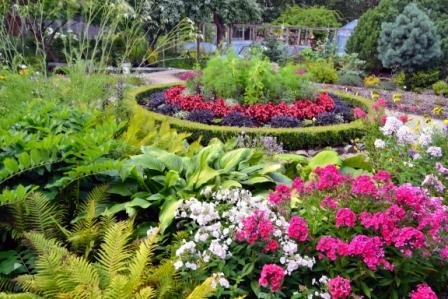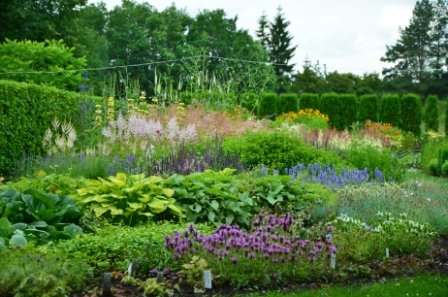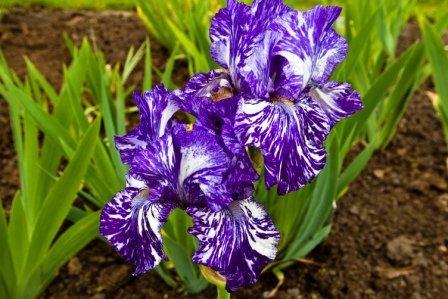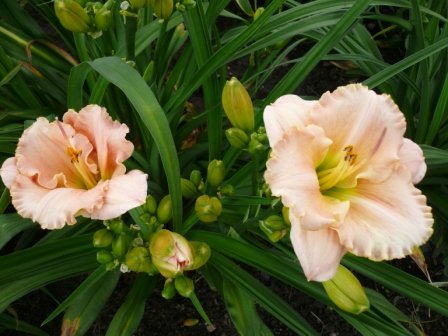
The purpose of the division is to gather ornamental herbaceous outdoor plants, broaden and exhibit their collection.
The division includes around 1290 plant taxa with over 20 annual, 10 biennial and 1260 perennial species. The majority of species and breeds belong to astilbe, peony, alumroot, dahlia, lily, plantain lily, tulip, daylily and iris. The collection is mainly focused on the ornamental species of wild flora. The division also contains the genera of bugbane, (Cimicifuga), American cowslip (Dodecatheon), fritillaria (Fritillaria), penstemon (Penstemon), which are less common in flower gardens.
Origin. The majority of flower breeds were brought from Estonia, Latvia, Poland as well as Lithuanian florists and botanical gardens. Some plants were grown from seeds, received from various botanical gardens worldwide via the seed exchange programme.
We are very grateful to Šiauliai city florists for their generous cooperation and contribution to our collection. In 2010 former architect and famous florist Vida Marcinkevičienė’s bearded iris flower collection was donated by her daughter Aušrinė as a memento of her mother. Vida Marcinkevičienė admired our botanical garden and generously shared her rarest plants with us. Algirdas Gražys—a plant breeder from Panevėžys—annually contributes his new dahlia breeds to our collection. Other exquisite dahlia breeds were donated by a florist Meilutė Mociškytė from Kurkliečiai village (Rokiškis region). Various decorative plants were presented by Genovaitė Pociūlienė, Rasa Miceikienė and Janina Vestartienė.

The area of floriculture division contains 18 ares. In order to reveal the decorative nature of plants, much attention is paid to soil improvement. The flowers are planted in geometric formations as this method is more convenient for cultivation and maintenance.Growing Conditions
Fascinating plants
The division of floriculture consists of numerous plant species with captivating ornamental properties and extensive variety. Lilies (Lilium) are one of the most beautiful flowers grown in the garden. The beauty of their blossoms mesmerises the visitors. Lilies used to play an important role in Lithuanian folklore: white lily, also known as Madonna lily, was a symbol of purity and innocence. Lilies are used for wedding bouquets as well as in funerals for guiding the departed to an eternal rest. In Ancient Rome, white lilies (Lilium candidum) symbolised elegance, wealth, luxury and hope. Martagon lily (Lilium martagon) is sometimes referred to as the “lily of Christ”.
Trilliums (Trillium) are one of the rarest plants in the collection. The plants come from North America and Eastern Asia and are prone to shady environments. They grow 20–40 cm. in height and bloom in white, yellow, pink and burgundy blossoms during the months of April and May. Trilliums are adored for their ornamental leaves and elegant flowers.
Springadonis (Adonis vernalis) is a rare perennial herbaceous plant, 20–40 cm in size. Its stem is rich in leaves with a big yellow flower of 3–7 cm in diameter. Springadonis produces its first flowers after 10–20 years that bloom from April to June. All parts of the plant are poisonous !

Small bulbous plants, such as crocuses (Crocus), hyacinths (Hyacinthus), grape-hyacinths (Muscari), early-flowering tulips (Tulipa), etc. are the first to bloom in the division during spring. The blooming period in the division starts from June and lasts until August. During the period various flowers, including tulips, fritillaries (Fritillaria), lilies (Lilium), irises (Iris), peonies (Paeonia), daylilies (Hemerocalis), trilliums (Trillium), coneflowers (Echinacea) produce beautiful blossoms. These flowering plants are popular due to their long blooming period as well as the glamour and variety of their flowers. During the month of September one can still find some blooming flowers in the division, such as dahlia, silvergrass (Miscanthus), moorgrass (Molinia), pennisetum (Pennisetum), aster (Aster) and many others.The blooming season
Short history
The division was started in 2004 for cognitive and scientific purposes. During the first stage of flower collection development several main genera, popular in ornamental gardening, were selected, which included lilies (Lilium), daylilies (Hemerocallis) and irises (Iris). Since the foundation of the division in 2004 until the year 2014 it was maintained by a professional florist Aldona Grišaitė. After 2014 the division is administrated by a senior supervisor of botanical collections Indrė Šklenikienė.
Division supporters
Company “Rėkyva” provides peat substrates to the division; liquid organic fertilisers are supplied by companies “Sliekas” and “Raskila”. Valuable plants are annually donated by our friends—Latvian flower farm “Bērziņi“. We are very grateful for all your support!
The division is administered by a senior supervisor of botanical collections Rita Šulskienė, e-mail: rita.sulskiene@sa.vu.lt

